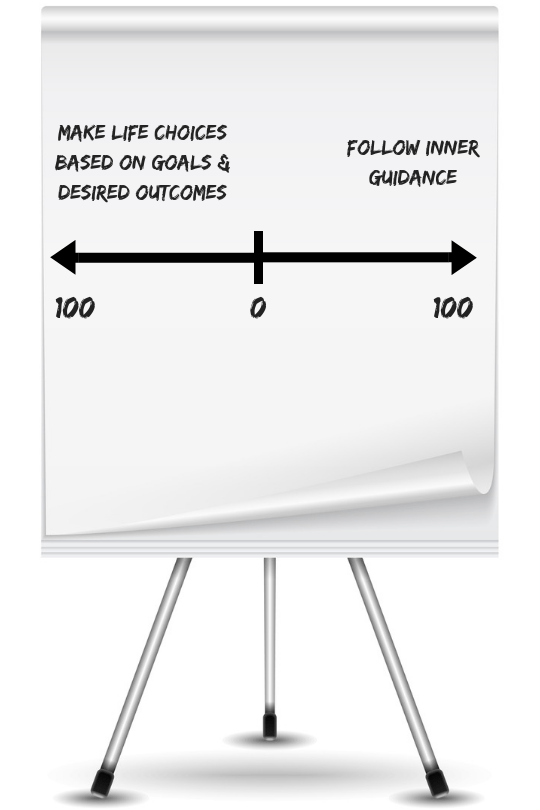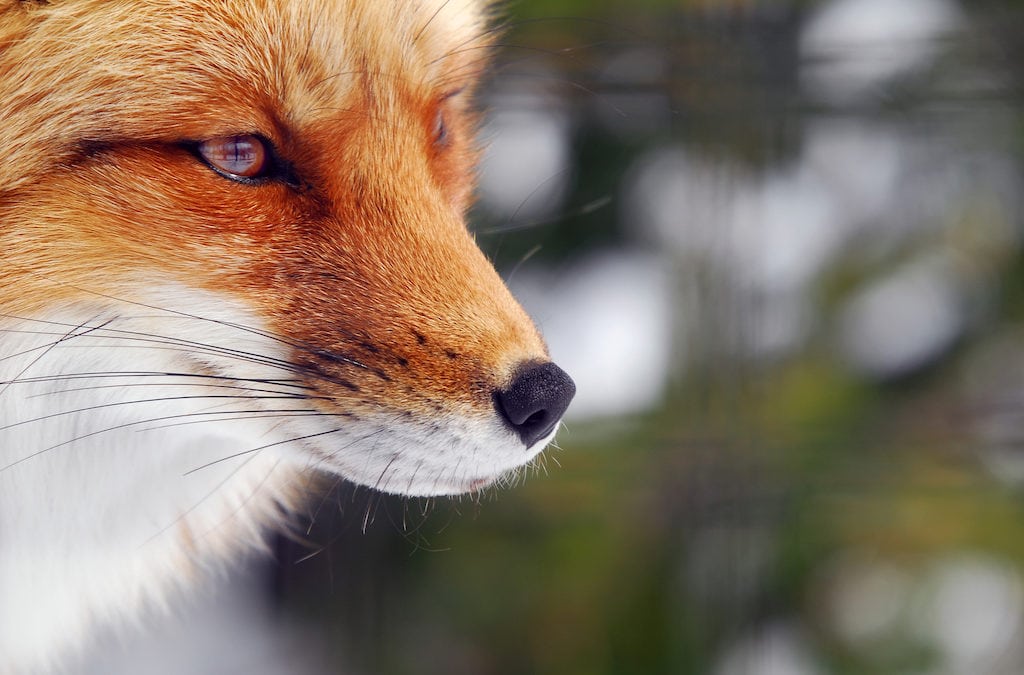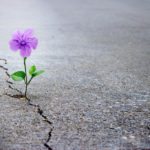This weekend, I was doing a coaching intensive with a client who seemed to view life as a series of either/or choices to be navigated. “I need to decide,” he said multiple times, “whether to do this (job, career, life choice A) or that (job, career, life choice B). The life he was living inside his head was so binary it reminded me of the humorist Robert Benchley’s classic one-liner:
There may be said to be two classes of people in the world; those who constantly divide the people of the world into two classes, and those who do not.
As is often the case when someone’s reality looks so differently to them than mine looks to me, I sat with it until something occurred to me like a bolt from the blue and I drew a binary diagram of my own up onto a flip chart and asked him to mark down where he lived on it:

I explained the two sides of the diagram as representing two fundamentally different approaches to life. On the left is a kind of an “outside-in path” where we set goals, targets, and directions and use them to guide our life choices.
By way of contrast, the right side of the diagram, living a guided life, points to an “inside-out path” where our moment to moment decisions are essentially made by an inner guidance system independent of our self-determined goals. We become more instinctive in the way we live our life, doing what we know to do in each moment and letting the chips fall where they may.
The question is not which is the “right” way to live. The question is which set of underlying assumptions about how life works is more accurate.Click To TweetIf happiness and fulfillment come from pursuing and reaching goals and we have the ability to make smart life choices (the outside-in path), the left-hand path is clearly the better option. But are either of those assumptions true?
The single biggest epiphany I have had into the human condition is the realization that we were born happy and that this innate sense of safety, security, and wellbeing never actually goes anywhere. In the words of the Scottish mystic Syd Banks, “Every human being is sitting in the middle of mental health – they just don’t know it.”
My entire life changed on a dime in that moment of seeing, and a lifetime of depression and suicidal ideation redefined itself from “the way I was made” to “the way I had inadvertently learned to cope with life”. I began to experience a kind of inner happiness, contentment, and peace that existed independent of circumstances. My life goals went from the necessary means towards a happy end to a mostly fun way of playing in what the Taoists call “the world of 10,000 things”.
As I began to live more and more from wellbeing and less and less in pursuit of it, I became aware of something else:
Human beings are terrible at predicting the future.Click To TweetOutside of creating and living into self-fulfilling prophecies, things so rarely turn out the way we think they will it’s kind of a testament to human optimism that we persist in thinking that they will. Not only do things often work out differently than we thought they would, things we thought would make us happy often don’t and things we thought would make us miserable often turn out far differently to how we imagined them.
So if your goals can’t make you happy and your life choices are based at best on a series of educated guesses, using goals and choices as a navigational path is like orienteering with a broken compass. But what’s the alternative?
Syd Banks talked about it like this:
“Mind is the intelligence of literally all things in this world or any other world… it’s the Mind that has the power to guide you through life.”
I often refer to the intersection of that universal Mind with our individual biology as ‘the deeper mind’. It’s a kind of real-time responsive intelligence inside us that already guides 95% of our actions and choices, but we tend to abandon it in favor of the power of prophecy when we think a pending decision is particularly important to our present and future wellbeing.
Yet in any given moment, we either know what to do or we don’t. And what we call decisions are just those difficult looking things we see when we drop out of the flow of our inner knowing and get caught back up in our habitual thinking.
The recognition of these three things is what leads us to begin living a guided life from the inside-out:
1. Our wellbeing is innate and never at risk from anything other than our in the moment thinking.
2. We’re terrible at predicting the future.
3. We have a reliable wisdom and common sense inside of us that guides us when we let it.
In this sense, living a guided life is different from just “trusting the universe” or “going with the flow” because we’re following an inner unfolding instead of being buffeted on the waves of an uncertain ocean of life circumstances and hoping everything will turn out for the best.
Here’s how I wrote about it in the new edition of Supercoach:
A man was walking through the woods outside his home one day when he came across a hungry fox who seemed to be at death’s door. Because he was a kind man, he thought to bring it some food, but before he could go back to his home, he heard a fearsome roar and hid behind a tree. In seconds, a mountain lion appeared, dragging the carcass of its freshly caught prey. The lion ate its fill and then wandered off, leaving the remains for the grateful fox.
The man was overwhelmed by this example of an abundant and benevolent universe and decided that he wouldn’t return to his home or his job. Instead of working hard to provide for himself, he would follow the example of the fox and allow the universe to provide for him.
Needless to say, the fox wandered off, and as days turned to weeks, the man himself was hungry and at death’s door. Despite his best efforts to retain his faith, he was becoming desperate. In a rare moment of inner quiet, he heard the still, small voice of his own wisdom: ‘Why have you sought to emulate the fox instead of the lion?’
With that, the man returned home and ate his fill.
Will my client stop trying to force himself to make binary choices in pursuit of goals he thinks will make him happy and fulfilled? To the extent he sees that life doesn’t work that way, yes. Because we’re already living a guided life within the bounds of the thinking we have that seems real to us about how life works.
And when we see better (i.e. more in line with the way life actually works), we do better and have a better experience of being alive – no effort or decisions required.
With all my love,
![]()






